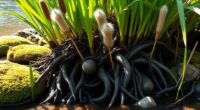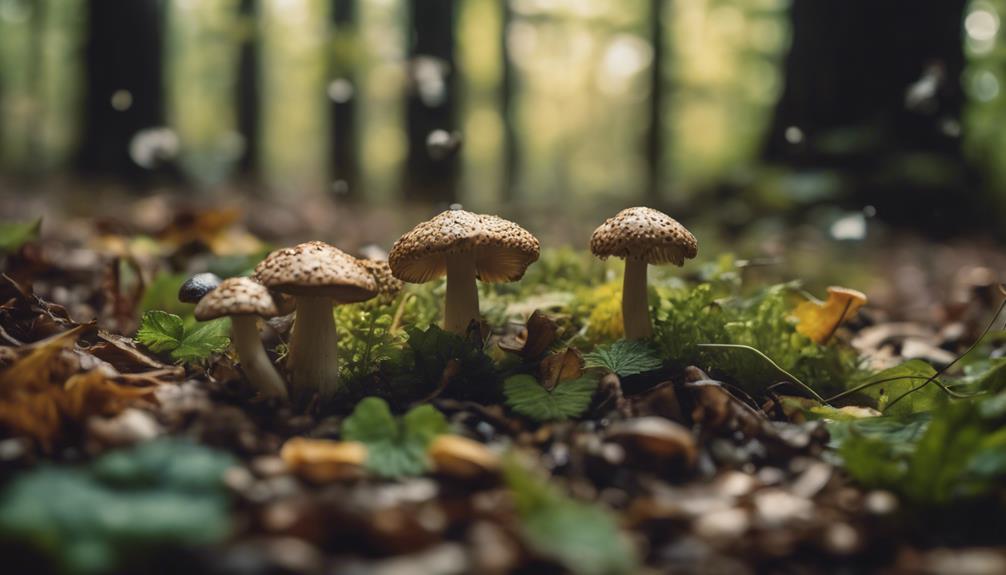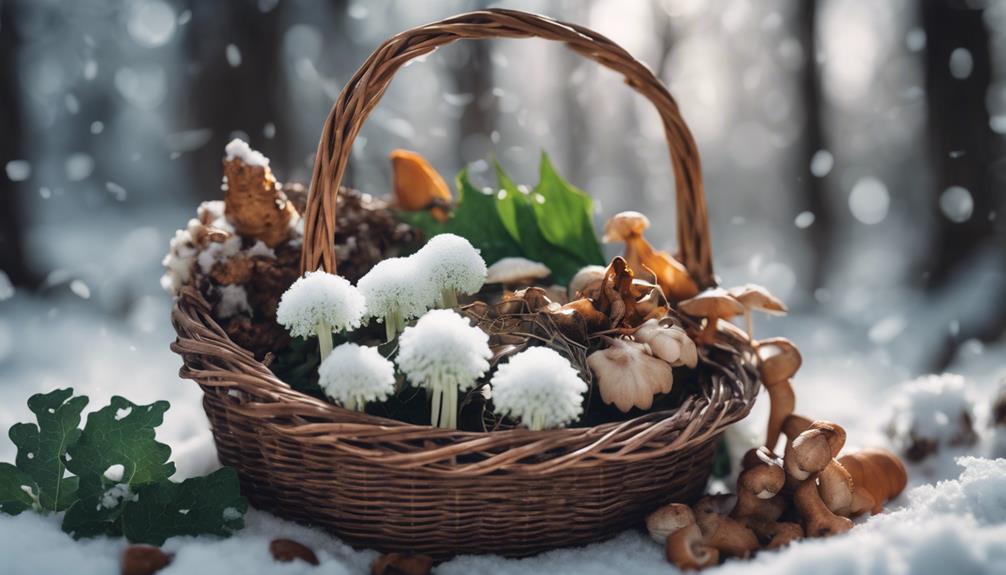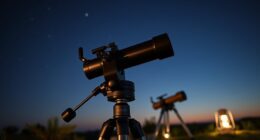To forecast epic mushroom flushes, use weather apps to track rainfall, humidity, and soil temperature closely. Look for patterns like recent rain followed by warm, moist conditions, typically between 55°F and 70°F, which signal prime growth times. Monitoring these factors helps you anticipate the best foraging windows and avoid risky periods. Keep an eye on how weather influences fungi activity, and you’ll find more ways to boost your mushroom hunting success.
Key Takeaways
- Use weather apps to monitor recent rainfall, soil moisture, humidity, and temperature for accurate mushroom growth predictions.
- Look for patterns of consistent rain followed by warm temperatures (55°F-70°F) to anticipate mushroom flushes.
- Track stable moisture levels and humidity to identify optimal foraging windows and prevent premature or delayed harvesting.
- Combine weather data with knowledge of specific mushroom species to improve identification and reduce risks.
- Stay alert to sudden weather changes that could affect mushroom development or cause spoilage, ensuring timely and safe foraging.
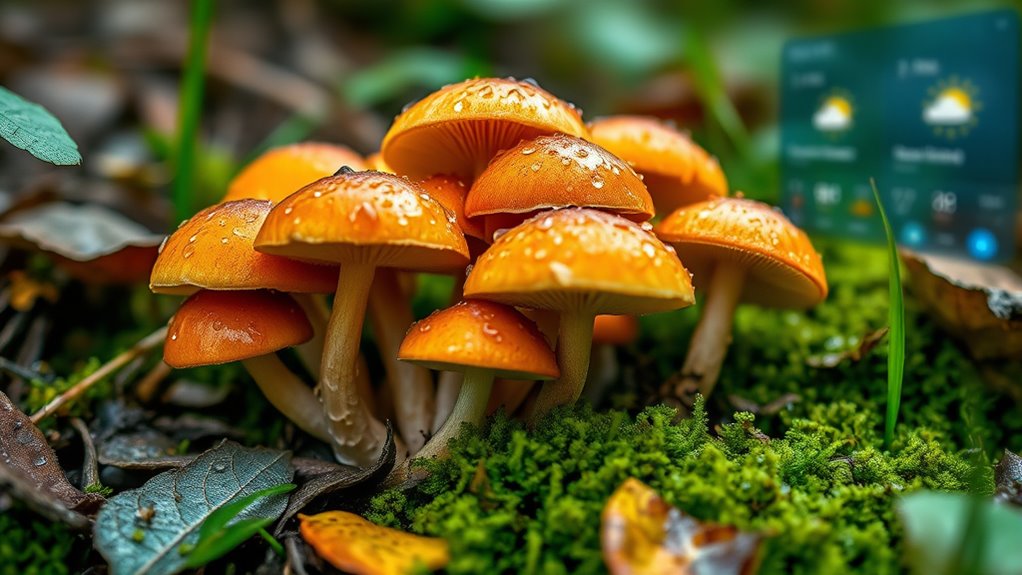
As fungi continue to thrive in changing climates, understanding their patterns becomes more important than ever. With weather apps now more advanced than ever, you have an incredible tool at your fingertips to predict when mushroom flushes might occur. By paying close attention to specific weather conditions, you can plan your foraging trips more effectively and increase your chances of finding a bountiful harvest. However, before heading out, it’s essential to master mushroom identification to avoid dangerous look-alikes and to guarantee your foraging safety. Recognizing edible species from toxic ones isn’t always straightforward, so staying informed and cautious is key.
Weather plays a major role in mushroom growth. Generally, after a period of rain followed by warm temperatures, you’ll notice a surge in mushroom activity. Many fungi species thrive in moist, humid conditions, so monitoring rainfall levels and soil moisture through weather apps can give you early warning signs. For example, a forecast predicting consistent rain over a few days, with temperatures ranging between 55°F and 70°F, often signals the ideal conditions for many common edible mushrooms like chanterelles or morels. As you track these patterns, you can time your foraging excursions to coincide with peak mushroom productivity, maximizing your chances of a successful harvest.
Monitoring rainfall and soil moisture helps predict peak mushroom growth periods.
Using weather data to forecast mushroom flushes also helps you avoid risky situations. If the forecast suggests a sudden drop in temperature or a dry spell following rain, it might be wiser to hold off on foraging. Mushrooms can be abundant during specific windows, but they also rot quickly if conditions change. By staying attentive to the weather, you not only increase your success rate but also practice foraging safety. Remember, some mushrooms look similar to toxic varieties, so proper mushroom identification is vital before harvesting. Never rely solely on appearance—consult reliable guides, or better yet, go with experienced foragers, especially when trying new species.
Incorporating weather apps into your mushroom hunting routine makes the entire process more predictable and less risky. Keep an eye on forecasts that include humidity, soil temperature, and recent rainfall data. These details help you anticipate when certain fungi will fruit and when the conditions might turn unfavorable. Combining this knowledge with careful mushroom identification ensures that your foraging is both successful and safe. As you become more attuned to weather patterns and mushroom species, you’ll gain confidence in your ability to harvest responsibly, enjoying the thrill of the hunt while respecting nature’s delicate balance. Utilizing weather data can further refine your foraging strategy by providing detailed insights into soil moisture levels, which are crucial for mushroom development.
Frequently Asked Questions
Which Mushroom Species Are Most Likely to Appear During Peak Flushes?
During peak flushes, you’re most likely to see species like Agaricus bisporus, which rely on spore dispersal for reproduction, and oyster mushrooms that emerge when mycelium activity intensifies with moisture. These species thrive in ideal conditions, especially when weather apps predict high humidity and rain, promoting spore release and mycelium growth. Keep an eye on local reports, as these factors increase your chances of finding these popular, abundant mushrooms.
How Accurate Are Weather Apps in Predicting Mushroom Hunting Conditions?
Imagine your hands brushing damp soil, sensing the moisture that sparks mushroom growth. Weather apps can be quite accurate in predicting these conditions, especially when soil moisture and recent rainfall are considered, as they influence fungal spores’ germination. While not perfect, they give you a solid heads-up on prime hunting days. Just remember, local microclimates and soil health also play big roles in whether mushrooms actually appear.
Can I Identify Edible Mushrooms Solely Based on Weather Forecasts?
You can’t reliably identify edible mushrooms solely based on weather forecasts. While warm, moist conditions may encourage mushroom growth, identifying edible types requires examining features like mushroom color and spore print. Relying only on weather apps could lead to dangerous mistakes, since many look alike. Always check physical characteristics carefully and consult field guides or experts before consuming any wild mushrooms.
What Tools or Apps Are Best for Tracking Mushroom Growth Patterns?
They say, “Knowledge is power,” and when tracking mushroom growth, the right tools make all the difference. You should explore apps like iFungi and Shroomify, which help monitor weather patterns and growth cycles. Also, check mycology journals and foraging forums for expert advice and updates. These resources can boost your success, making your mushroom hunting more precise and enjoyable. Combining technology with community insights is your best bet.
Are There Any Safety Tips for Foraging During Predicted Mushroom Peaks?
When foraging during predicted mushroom peaks, you should always follow foraging gear guidelines to stay safe. Carry a good field guide to identify poisonous look-alikes, and never eat a mushroom unless you’re 100% sure it’s safe. Use a knife to harvest carefully, and bring a basket to avoid damaging the mycelium. Always forage with a knowledgeable companion if you’re unsure, and avoid areas with heavy pollution.
Conclusion
By harnessing the power of weather apps, you can anticipate those incredible mushroom flushes, turning fleeting moments into unforgettable harvests. Think of each forecast as a secret whisper from nature, guiding you to the next bounty. Don’t let these fleeting treasures slip away—embrace the magic of prediction and become a true fungi finder. After all, isn’t it extraordinary how a simple app can reveal the hidden wonders beneath your feet?


